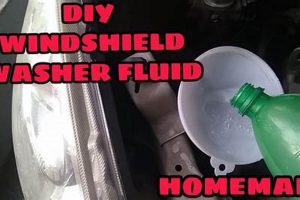The practice of applying powdered acrylic to the nail plate, often utilizing a resin adhesive, to create a durable and aesthetically pleasing coating is a popular alternative to traditional nail polish or gel manicures. This method allows individuals to achieve salon-quality results within the confines of their own homes. As an example, an individual might apply a base coat, dip their nail into colored powder, and then seal it with an activator and topcoat.
This nail enhancement technique provides several advantages, including relative ease of application, quick drying time, and extended wear compared to conventional methods. Historically, similar powder-based nail treatments have been utilized, but recent advancements in resin and powder formulations have significantly improved durability and aesthetic options. The growing demand for cost-effective and convenient beauty solutions has fueled its increasing popularity.
The subsequent sections will delve into the specific tools and materials required, a step-by-step guide for successful application, tips for troubleshooting common issues, and best practices for removal and maintenance to ensure optimal nail health and longevity of the manicure.
Application Guidance
To ensure a professional and long-lasting manicure using the dip powder method, adherence to specific techniques is crucial. The following guidelines provide detailed instructions for each stage of the process.
Tip 1: Nail Preparation: Proper preparation is paramount. Ensure nails are thoroughly cleaned, buffed lightly to remove shine, and dehydrated with alcohol or a nail dehydrator. This enhances adhesion and longevity.
Tip 2: Thin Layers: Apply the bonding agent in thin, even coats. Excessive product buildup can lead to uneven coverage and potential lifting. Dip the nail at a 45-degree angle to prevent powder from adhering to the cuticle area.
Tip 3: Powder Application: When applying the powder, gently tap off excess. Avoid pressing the nail directly into the powder, as this can cause contamination and clumping. Multiple thin layers are preferable to a single thick layer.
Tip 4: Activation: Apply the activator according to the manufacturer’s instructions. Over-application can cause the dip powder to harden prematurely, hindering filing and shaping. Ensure the activator is fully dry before proceeding to the next step.
Tip 5: Filing and Buffing: File and buff the nail surface to achieve the desired shape and smoothness. Use a fine-grit buffer to refine the surface and remove any imperfections. This step significantly impacts the final appearance.
Tip 6: Top Coat Application: Apply a high-quality top coat in thin, even layers. Allow each coat to dry completely before applying the next to prevent streaking and ensure a glossy finish. Two coats are generally recommended for optimal results.
Tip 7: Cuticle Oil: Finish the manicure by applying cuticle oil to hydrate the skin surrounding the nails. This promotes healthy nail growth and enhances the overall appearance of the finished manicure.
Following these guidelines contributes to a more durable, aesthetically pleasing, and professional-looking manicure. Proper execution minimizes the risk of lifting, chipping, and other common issues associated with this application method.
With the successful execution of these steps, the individual may now explore advanced techniques or considerations for removal, ensuring the longevity and health of the natural nail.
1. Preparation
Proper preparation is foundational to achieving a successful and long-lasting at-home dip powder manicure. Neglecting this crucial initial phase will invariably lead to suboptimal results, including lifting, chipping, and an overall compromised aesthetic.
- Nail Cleaning and Sanitization
Thoroughly cleaning the nail plate removes oils, debris, and contaminants that impede adhesion. Utilizing a dedicated nail cleanser or isopropyl alcohol ensures a pristine surface for product application. Inadequate cleaning leads to poor bonding, resulting in premature lifting of the dip powder.
- Cuticle Management
Gentle pushing back and removal of non-living cuticle tissue is essential. Cuticle encroachment onto the nail plate can interfere with product adhesion, causing lifting and potential infection. Proper cuticle management involves utilizing specialized tools and techniques to ensure a clean and unobstructed nail surface.
- Nail Plate Buffing and Shaping
Lightly buffing the nail plate creates a slightly textured surface, enhancing the bonding of the base coat. Shaping the nails to the desired form prior to application ensures a uniform and aesthetically pleasing final result. Uneven or improperly shaped nails will compromise the overall appearance of the manicure.
- Dehydration
Application of a nail dehydrator removes residual moisture from the nail plate, further improving adhesion. Moisture trapped beneath the dip powder can lead to bacterial growth and lifting. Complete dehydration is a critical step in ensuring a durable and hygienic manicure.
These facets of preparation collectively contribute to a solid foundation for the dip powder application. Omission of any of these steps will increase the likelihood of encountering issues, ultimately diminishing the quality and longevity of the manicure. Attention to detail during this initial phase is crucial for achieving professional-level results in a at-home setting.
2. Application Technique
The methodology employed in applying dip powder directly impacts the final outcome and durability of at-home manicures. Consistent and precise application techniques are critical for achieving salon-quality results and minimizing potential issues such as lifting or uneven surfaces.
- Base Coat Application
The initial application of the base coat must be thin and even, ensuring complete coverage of the nail plate. Excessively thick applications can lead to product pooling and uneven curing, resulting in a compromised bond between the natural nail and the dip powder. Inconsistent base coat application directly affects the longevity and structural integrity of the manicure.
- Powder Dipping Method
The angle and duration of the dipping process influence the thickness and uniformity of the powder layers. A consistent 45-degree angle and a brief dipping time prevent excessive powder accumulation. Holding the nail in the powder for too long can result in a bulky and uneven finish, requiring extensive filing and potentially weakening the overall structure.
- Activator Application
The activator solution initiates the hardening process of the dip powder. An even and controlled application of the activator ens
ures uniform curing. Over-application of the activator can lead to premature hardening, making it difficult to shape and file the nails. Conversely, insufficient activator results in a soft and unstable coating. - Sealing and Top Coat Application
The top coat seals the dip powder layers, providing a protective barrier and a glossy finish. Thin and even layers of top coat are essential to prevent streaking and bubbling. Rushing the drying process or applying thick layers can compromise the final appearance and durability of the manicure.
These facets of the application technique demonstrate the intricate connection between procedural steps and the ultimate quality of a do-it-yourself dip powder manicure. Mastering these techniques is essential for achieving a professional-looking result and maximizing the lifespan of the manicure.
3. Layer Thickness
The thickness of each layer applied during the process directly affects the durability, appearance, and overall success of at-home dip powder manicures. Proper management of layer thickness prevents a range of issues, including brittleness, uneven surfaces, and compromised adhesion.
- Structural Integrity and Durability
Excessively thick layers create a rigid coating prone to cracking and chipping. While seemingly adding strength, overly thick applications lack flexibility and cannot withstand daily wear and tear. Conversely, layers that are too thin provide insufficient protection, leading to premature breakage and peeling. The optimal thickness balances protection with flexibility for enhanced durability.
- Appearance and Smoothness
Uneven or overly thick layers result in a bumpy, unprofessional-looking finish. Achieving a smooth, even surface requires meticulous application of thin, consistent layers. Thick layers often require excessive filing to smooth, which can weaken the structure and alter the intended shape. Proper layer thickness minimizes the need for extensive filing, preserving the integrity of the manicure.
- Adhesion to the Natural Nail
Overly thick layers can impede proper adhesion to the natural nail plate. The bulkiness of the coating can create stress points, increasing the likelihood of lifting and separation. Thin, well-adhered layers create a stronger bond, reducing the risk of lifting and prolonging the lifespan of the manicure. The base coat plays a crucial role in facilitating this initial adhesion, and its thickness must also be carefully managed.
- Product Usage and Cost-Effectiveness
Applying excessive layers of dip powder leads to unnecessary product consumption and increased cost. Utilizing thin, controlled layers maximizes the use of each product, extending the lifespan of the dip powder and other essential materials. Efficient product usage is a key factor in the cost-effectiveness of do-it-yourself nail applications.
Effective control over layer thickness is a fundamental aspect of successful at-home dip powder manicures. Maintaining an optimal balance between protection and aesthetic appeal requires careful attention to each layer applied. Mastering this technique significantly enhances the quality, durability, and overall satisfaction with self-administered nail enhancements.
4. Activation Timing
Activation timing represents a critical variable in the successful execution of dip powder nail applications. The activator solution initiates the hardening process, transforming the powdered acrylic into a durable coating. Premature or delayed activation directly impacts the structural integrity and aesthetic outcome of the final manicure. Inadequate activation leads to a soft, unstable coating prone to chipping and damage, while excessive activation can result in premature hardening, hindering the filing and shaping process necessary for achieving a smooth, professional finish. For instance, if the activator is applied too sparingly, the powder may remain grainy and lack the necessary hardness for long-term wear. Conversely, over-application can cause the powder to harden too quickly, making it difficult to smooth imperfections and shape the nail effectively.
The practical significance of understanding activation timing extends to optimizing the longevity and appearance of the manicure. Proper activation ensures the powder is fully hardened, providing a robust barrier against daily wear. Furthermore, controlled activation allows for precise filing and shaping, enabling the user to achieve the desired nail shape and smooth surface texture. For example, if the user intends to create a sharp, defined nail shape, they must ensure the powder is adequately activated before attempting to file. Similarly, achieving a glossy, seamless finish requires the surface to be properly activated before the application of the top coat. Incorrect activation can compromise the structural integrity, potentially leading to bending and splitting with the use of the nails.
In conclusion, accurate activation timing is paramount for achieving durable and aesthetically pleasing dip powder nail applications. Careful attention to the product manufacturer’s guidelines and adjustment based on environmental factors, like temperature and humidity, can significantly impact the outcome. Mastering this component mitigates common issues like chipping, lifting, and uneven surfaces. The knowledge gained contributes directly to the ability to achieve professional-quality results.
5. Filing Precision
Filing precision plays a decisive role in the success of at-home dip powder nail applications. The process involves shaping and smoothing the hardened dip powder to achieve the desired aesthetic and functionality. Inadequate precision during this stage directly impacts the final appearance, durability, and structural integrity of the manicure. For instance, uneven filing can result in an asymmetrical nail shape, detracting from the overall visual appeal. Similarly, aggressive filing can weaken the dip powder coating, rendering it more susceptible to chipping and breakage. Precision, therefore, is not merely an aesthetic concern but a fundamental aspect of creating a robust and long-lasting nail enhancement.
The consequences of neglecting filing precision are manifold. A poorly filed nail surface may exhibit ridges, bumps, or an inconsistent thickness. These imperfections not only detract from the visual appeal but also create areas of stress concentration, predisposing the manicure to premature failure. Moreover, imprecise filing can damage the natural nail plate, leading to thinning, weakening, and increased susceptibility to infections. One frequent example is the use of coarse files that, while efficient at material removal, can create microscopic fissures in the dip powder and the underlying natural nail, weakening the structure.
Effective filing techniques necessitate a combination of appropriate tools, controlled pressure, and methodical execution. A selection of files with varying grits is essential for shaping, smoothing, and refining the dip powder surface. Controlled pressure prevents excessive material removal, reducing the risk of weakening the coating. A methodical approac
h ensures a consistent and symmetrical nail shape. In summary, mastering filing precision is integral to achieving professional-quality results with at-home dip powder applications, minimizing potential damage, and maximizing the longevity and visual appeal of the manicure.
6. Top Coat Quality
The quality of the top coat applied to self-administered dip powder manicures directly influences the overall aesthetic, durability, and longevity of the finished product. The top coat serves as a protective sealant, shielding the underlying layers of colored powder from environmental factors such as UV radiation, abrasion, and chemical exposure. Substandard top coats often exhibit characteristics such as streaking, bubbling, or premature yellowing, detracting from the intended visual appeal. Conversely, a high-quality top coat provides a smooth, glossy finish that enhances the color and depth of the dip powder, resulting in a more professional and visually appealing outcome. For example, a low-quality top coat may become dull within a few days of application, requiring frequent reapplication or compromising the overall appearance. A superior product, however, can maintain its luster for an extended period, preserving the intended aesthetic.
The protective properties of the top coat also play a crucial role in preventing chipping, cracking, and peeling of the dip powder. A durable top coat acts as a barrier against physical damage, extending the lifespan of the manicure. The chemical composition of the top coat determines its resistance to common household chemicals and cleaning agents. Inferior top coats may be susceptible to degradation upon exposure to these substances, leading to discoloration or weakening of the protective layer. For instance, a manicure sealed with a low-quality top coat may exhibit staining or etching after exposure to common solvents, while a high-quality top coat remains unaffected. This protective function also contributes to the maintenance of hygiene, as a compromised top coat can allow moisture and bacteria to penetrate the underlying layers.
In conclusion, the selection of a high-quality top coat is a critical component of the at-home dip powder manicure process. Its impact extends beyond mere aesthetics, encompassing durability, protection, and longevity. Investing in a superior top coat translates to a more professional-looking, longer-lasting, and more resistant manicure, effectively safeguarding the underlying layers and maintaining the intended visual appeal. Challenges related to achieving a flawless finish can often be mitigated through the use of high-quality top coats and meticulous application techniques.
Frequently Asked Questions Regarding DIY Dip Nails
This section addresses common inquiries and misconceptions surrounding the application, maintenance, and safety of at-home dip powder nail systems. The provided information aims to offer clarity and guidance to ensure optimal results and minimize potential risks.
Question 1: Is professional training required to achieve satisfactory results with DIY dip nails?
While professional training is beneficial, it is not strictly required. Success hinges on meticulous adherence to established techniques, thorough preparation, and a comprehensive understanding of the products involved. Numerous resources, including detailed tutorials and guidelines, are readily available to assist individuals in mastering the process.
Question 2: What are the primary risks associated with improper application or removal of DIY dip nails?
Improper application can lead to fungal infections, allergic reactions, and weakening of the natural nail plate. Aggressive filing or forced removal can cause thinning, brittleness, and separation of the nail layers. Strict adherence to recommended application and removal protocols is essential to mitigate these risks.
Question 3: How can one minimize the risk of contamination during the dip powder application process?
Contamination can be minimized through rigorous hygiene practices. Individual containers of dip powder should be used for each client to prevent the transfer of bacteria and fungi. Application tools must be thoroughly sanitized between uses. Avoid double-dipping to maintain the integrity of the powder and prevent cross-contamination.
Question 4: What are the indicators of an allergic reaction to DIY dip nail products, and what course of action is recommended?
Indicators of an allergic reaction include redness, itching, swelling, and blistering around the nail area. Discontinue use immediately upon experiencing these symptoms. Seek medical attention from a dermatologist or qualified healthcare professional to receive an accurate diagnosis and appropriate treatment.
Question 5: How often should DIY dip nail applications be performed to maintain optimal nail health?
Frequent and continuous application of any artificial nail enhancement system can potentially weaken the natural nail. It is generally recommended to allow for periodic breaks to allow the nail plate to recover. The duration of these breaks should be determined based on the individual’s nail health and the frequency of dip powder applications.
Question 6: Are there specific ingredients to avoid when selecting DIY dip nail products to minimize potential health risks?
Certain ingredients, such as MMA (methyl methacrylate), have been associated with adverse health effects and are not recommended for use in nail products. Formaldehyde, toluene, and dibutyl phthalate (DBP) are also ingredients to be avoided whenever possible. Selecting products with a clear and complete ingredient list allows for informed purchasing decisions.
Proper training is essential to achieving satisfactory results with DIY dip nails. Risk mitigation revolves around strict adherence to hygiene practices, proper application, and informed product selection.
The following section will cover troubleshooting tips, and common pitfalls encountered when performing this process at home.
Conclusion
The preceding analysis has comprehensively explored the practice of DIY dip nails, encompassing essential techniques, potential challenges, and crucial considerations for both application and maintenance. The proper method for nail preparation, application, technique for each layer, the effect of activation timings, precise filling, and top coat quality will define the outcome and lifespan of DIY dip nail practices.
Ultimately, successful engagement with this practice hinges on informed decision-making, meticulous execution, and a commitment to prioritizing nail health. Further research and adherence to evolving best practices will continue to refine the accessibility and safety of at-home nail enhancement options.





![DIY Build: Circular Saw Crosscut Jig PDF Plans [Free] The DIY Hub: Creative Crafts, Repairs & Life Hacks DIY Build: Circular Saw Crosscut Jig PDF Plans [Free] | The DIY Hub: Creative Crafts, Repairs & Life Hacks](https://craftingdiycenter.com/wp-content/uploads/2025/07/th-5916-300x200.jpg)

